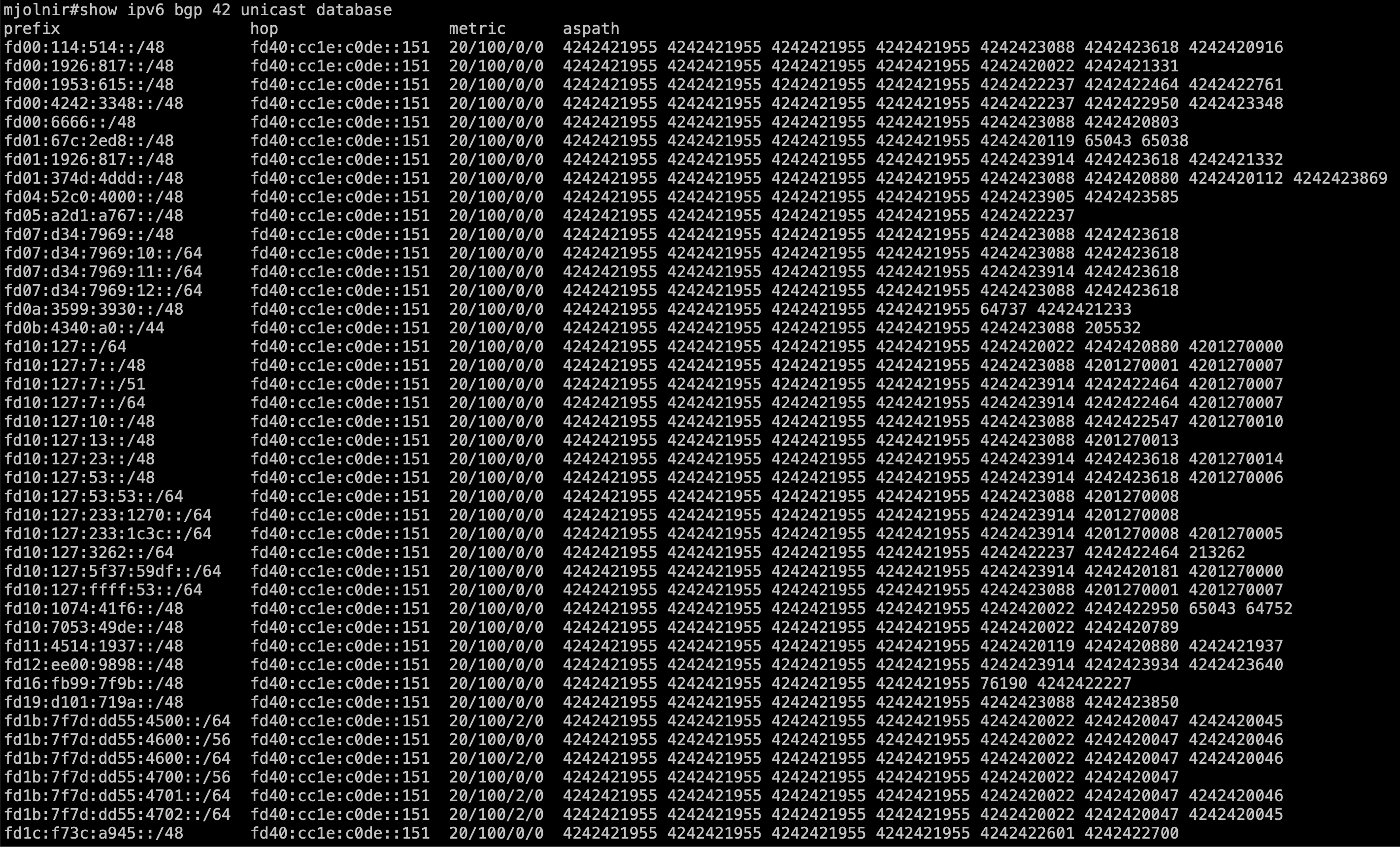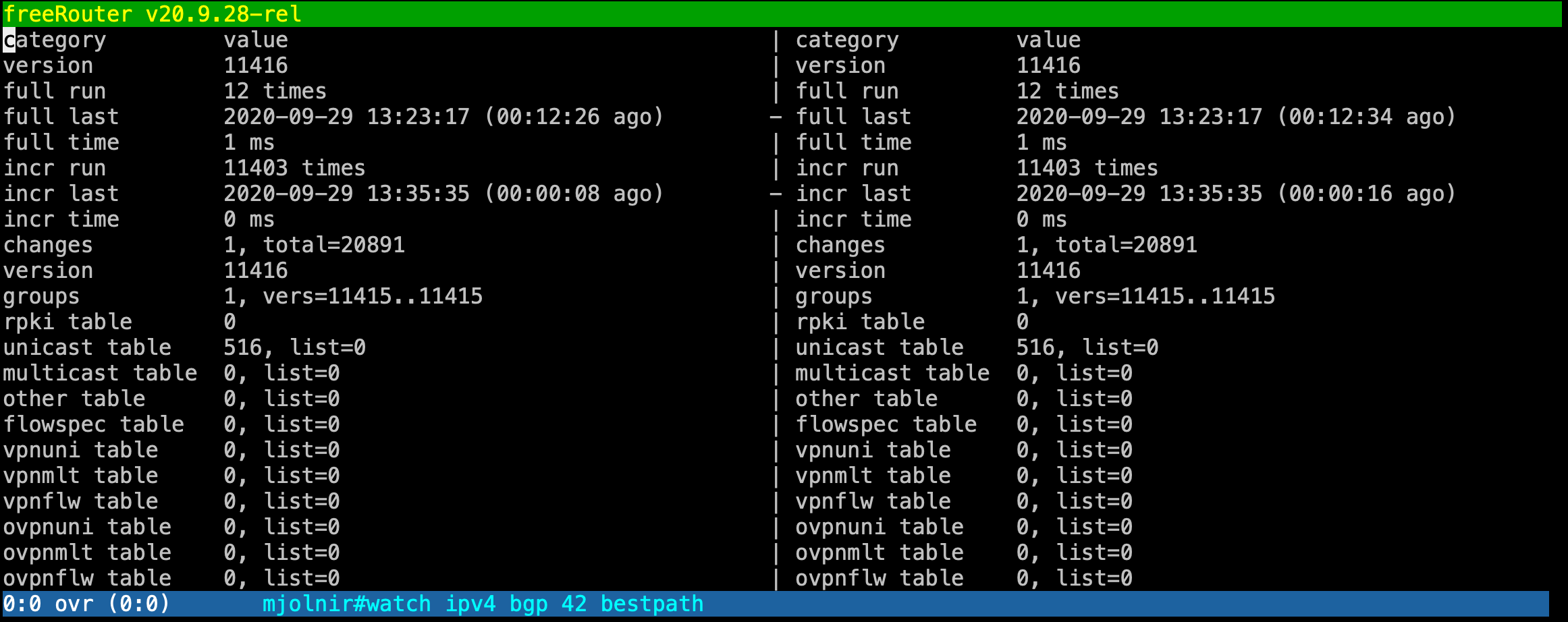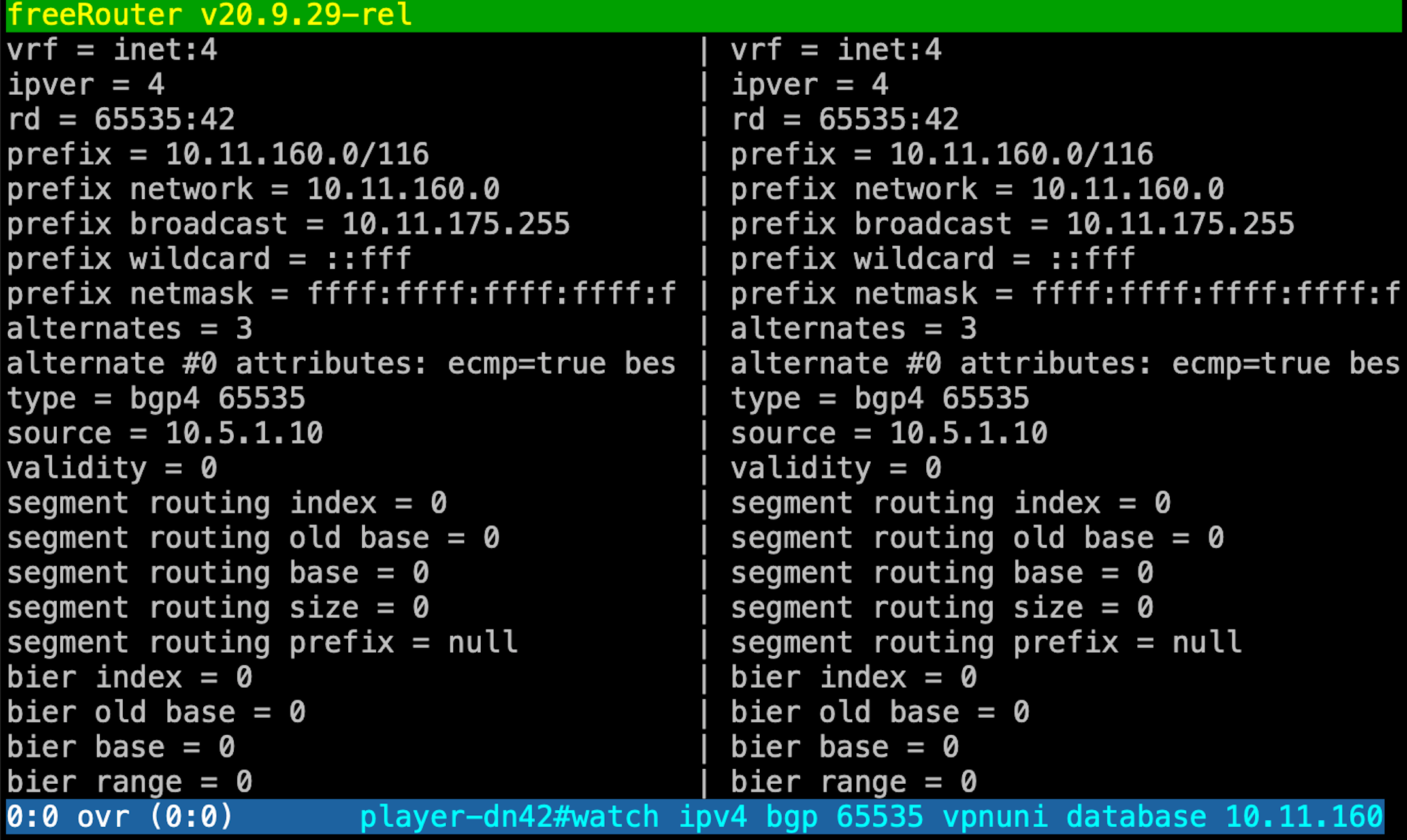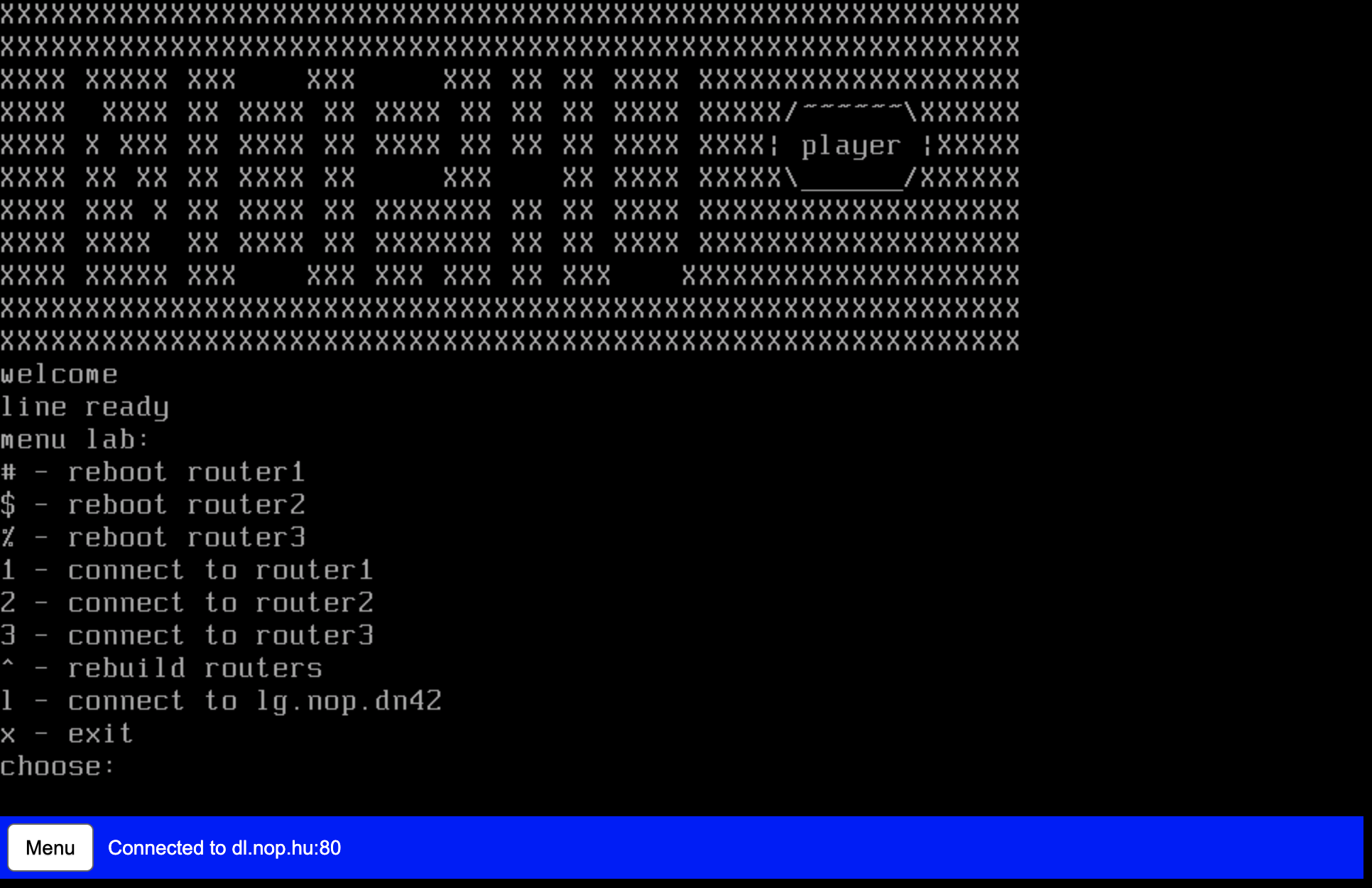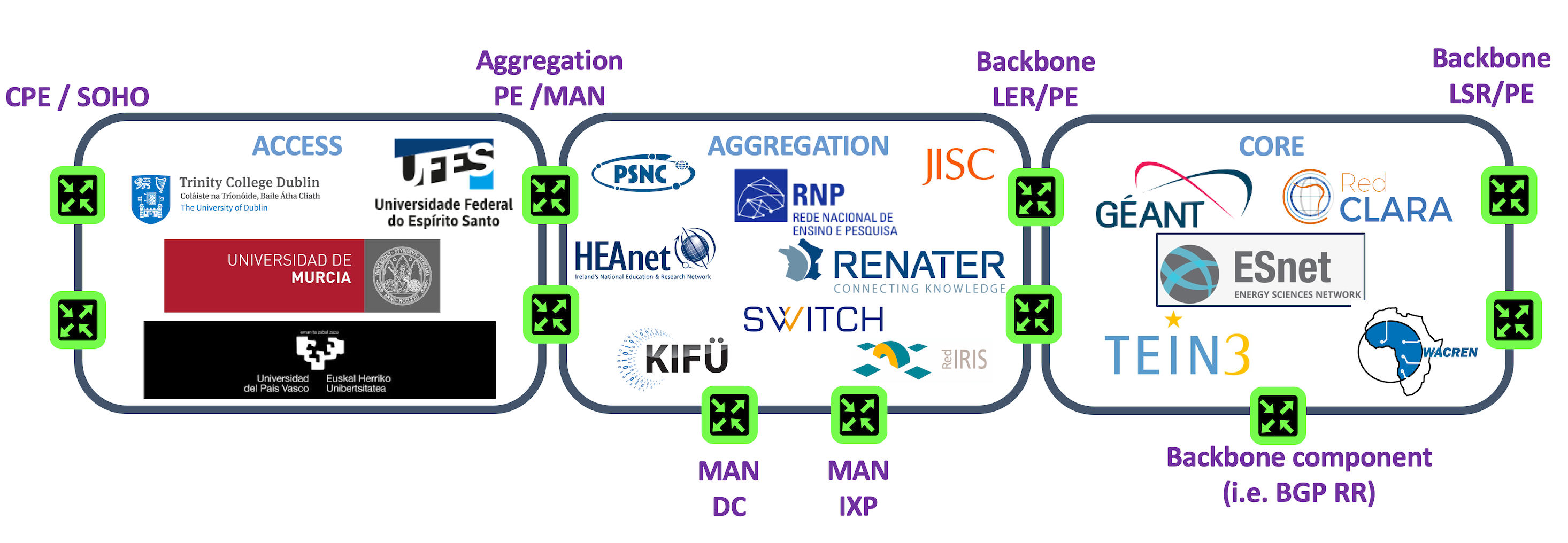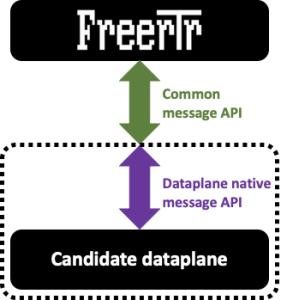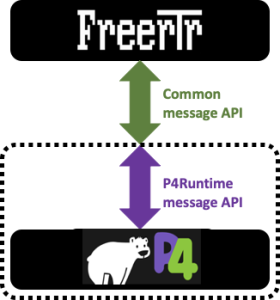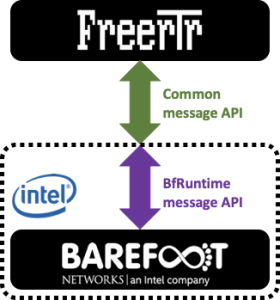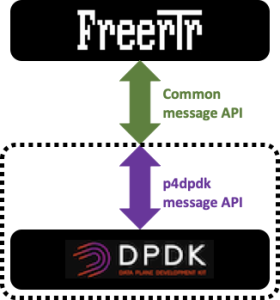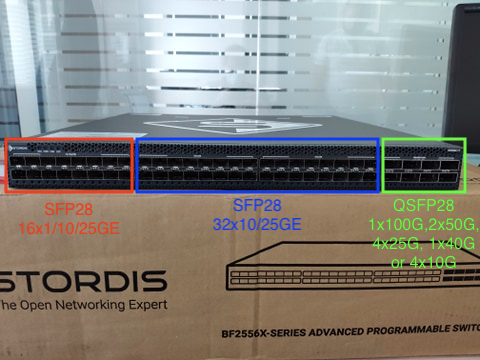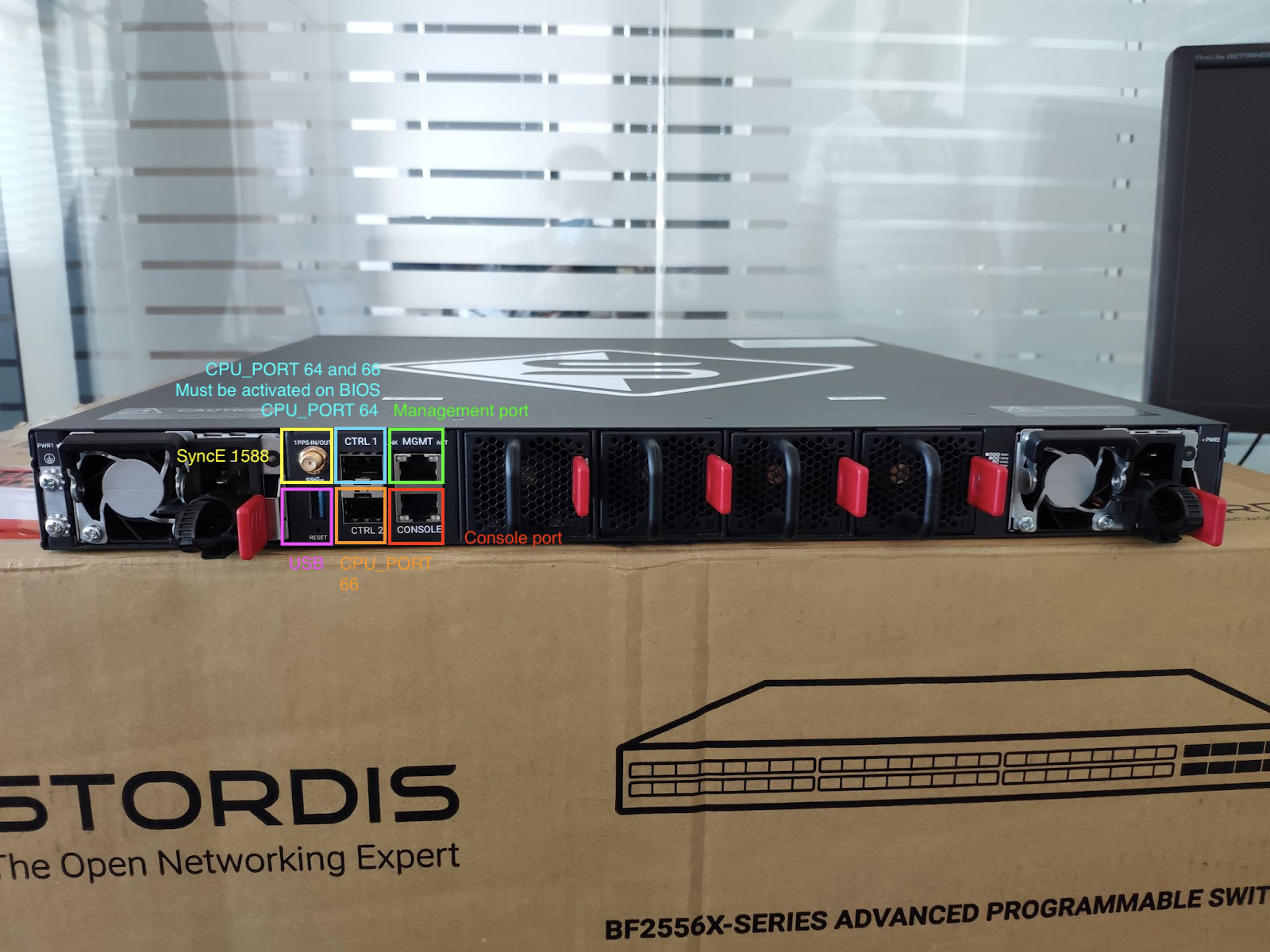Requirement
|
Overview
We all have our habits that are inherited from our past experience. Some people are used to IOS, IOS-XR, NX-OX, IOS-XE others prefer Junos etc. Using freeRouter provides a different user experience. Some feature such as show/view/watch/differ diagnosis commands are pretty unique to freeRouter. However, freeRouter have some cards in its sleeves in order to provide you a familiar experience.
Article objective
In this article, we will focus on these features:
- monitor
- length
- width
- spacetab
- tablemode
- timestamps
- colorized
Basically these commands are accessed through freeRouter user mode. If you need to use them from config mode, please use the "do" keyword.
[ #003 ] - "monitor/length/width/spacetab/tablemode/timestamps/colorized"
Discussion
monitor/length/width/spacetab/tablemode/timestamps/colorized is a set of feature meant to ease your experience with freeRouter in mimic'ing well know behaviour and proposing you additional convenient features. One main behaviour is that all command issue from the CLI is instantly taken into account.
Conclusion
In this 3rd article:
- We presented freeRouter monitor/length/width/spacetab/tablemode/timestamps/colorized terminal customization command
- These are very useful if you come from Cisco or Junos world as it mimic some termnal behaviour.
Final words
As said, these are terminal commands are not specific to freeRouter. Some behaviour are mimic'ed from IOS and Junos. Anyway, these have been developed for one purpose:
"Make network engineers feel at ease and provide then an enjoyable operation experience "
Feel free to try and use them according to your environment taste!
Last but not least, you can play with these different mode from this sandbox:
telnet dl.nop.hu Trying 193.224.23.5... Connected to dl.nop.hu. Escape character is '^]'. XXXXXXXXXXXXXXXXXXXXXXXXXXXXXXXXXXXXXXXXXXXXXXXXXXXXXXXXXXXX XXXXXXXXXXXXXXXXXXXXXXXXXXXXXXXXXXXXXXXXXXXXXXXXXXXXXXXXXXXX XXXX XXXXX XXX XXX XXX XX XX XXXX XXXXXXXXXXXXXXXXXXX XXXX XXXX XX XXXX XX XXXX XX XX XX XXXX XXXXX/~~~~~~\XXXXXX XXXX X XXX XX XXXX XX XXXX XX XX XX XXXX XXXX| player |XXXXX XXXX XX XX XX XXXX XX XXX XX XXXX XXXXX\______/XXXXXX XXXX XXX X XX XXXX XX XXXXXXX XX XX XXXX XXXXXXXXXXXXXXXXXXX XXXX XXXX XX XXXX XX XXXXXXX XX XX XXXX XXXXXXXXXXXXXXXXXXX XXXX XXXXX XXX XXX XXX XXX XX XXX XXXXXXXXXXXXXXXXXXXX XXXXXXXXXXXXXXXXXXXXXXXXXXXXXXXXXXXXXXXXXXXXXXXXXXXXXXXXXXXX XXXXXXXXXXXXXXXXXXXXXXXXXXXXXXXXXXXXXXXXXXXXXXXXXXXXXXXXXXXX welcome line ready menu lab: # - reboot router1 $ - reboot router2 % - reboot router3 1 - connect to router1 2 - connect to router2 3 - connect to router3 ^ - rebuild routers l - connect to lg.nop.dn42 x - exit choose:1 - attach vdc lab1 welcome line ready yourname#terminal ? colorized - sending to ansi terminal length - set terminal length monitor - log to this terminal no - negate a parameter spacetab - treat space as tabulator tablemode - select table formatting mode timestamps - put time before each executed command width - set terminal width yourname#terminal ...
In order to exit the sandbox session use the following escape sequence: Ctrl-c + Ctrl-x
Requirement
|
Overview
As previously mentioned in the precedent article, when you log into a network equipment such as a router, you tend to have some automatic reflex. You usually:
- Check router configuration: show run or sh conf
- Check ipv4 / ipv6 / or LFIB forwarding table
- So you basically issue diagnosis, troubleshooting command
- An then you want to configure the router
Article objective
In this article, we will focus on the 3rd bullet point and will present you freeRouter available diagnosis command. They are grouped into 5 categories:
- show
- view
- watch
- display
- differ
Basically these commands are accessed through freeRouter user mode. If you need to use them from config mode, please use the "do" keyword.
[ #002 ] - "show/view/watch/display/differ"
Discussion
show/view/watch/display/differ is pretty unique to freeRouter, and is really meant to provide you the best user experience as a network operator ! These command have proven to be helpful, especially if you deal with huge feed. However, be careful when you are working with very big output such BGP full feed. This won't crash the router of course as we used to when we issued "debug ip packet" but it will for sure imply a high CPU usage due to regular refresh at the control plane level.
Conclusion
In this 2nd article:
- We presented freeRouter show/watch/display/differ diagnisis command
- These are very useful when you have to deal with huge command output buffer.
Final words
As said, these are diagnosis commands are specific to freeRouter. 2 decades of know how and network experience have been pushed into these feature codes. These have been developed for one purpose:
"Provide a unique operation experience to network engineers"
Feel free to try and use them according to your environment taste!
Last but not least, you can play with these different mode from this sandbox:
ssh dl.nop.hu -l random_user Warning: Permanently added 'dl.nop.hu,193.224.23.5' (RSA) to the list of known hosts. random_user@dl.nop.hu's password: XXXXXXXXXXXXXXXXXXXXXXXXXXXXXXXXXXXXXXXXXXXXXXXXXXXXXXXXXXXX XXXXXXXXXXXXXXXXXXXXXXXXXXXXXXXXXXXXXXXXXXXXXXXXXXXXXXXXXXXX XXXX XXXXX XXX XXX XXX XX XX XXXX XXXXXXXXXXXXXXXXXXX XXXX XXXX XX XXXX XX XXXX XX XX XX XXXX XXXXX/~~~~~~\XXXXXX XXXX X XXX XX XXXX XX XXXX XX XX XX XXXX XXXX| player |XXXXX XXXX XX XX XX XXXX XX XXX XX XXXX XXXXX\______/XXXXXX XXXX XXX X XX XXXX XX XXXXXXX XX XX XXXX XXXXXXXXXXXXXXXXXXX XXXX XXXX XX XXXX XX XXXXXXX XX XX XXXX XXXXXXXXXXXXXXXXXXX XXXX XXXXX XXX XXX XXX XXX XX XXX XXXXXXXXXXXXXXXXXXXX XXXXXXXXXXXXXXXXXXXXXXXXXXXXXXXXXXXXXXXXXXXXXXXXXXXXXXXXXXXX XXXXXXXXXXXXXXXXXXXXXXXXXXXXXXXXXXXXXXXXXXXXXXXXXXXXXXXXXXXX welcome line ready menu lab: # - reboot router1 $ - reboot router2 % - reboot router3 1 - connect to router1 2 - connect to router2 3 - connect to router3 ^ - rebuild routers l - connect to lg.nop.dn42 x - exit choose:l - telnet 172.23.199.110 23 /telnet - connecting to 172.23.199.110 23 - securing connection hi there! try the following: show ipv4 route dn42 show ipv6 route dn42 show ipv4 bgp 65535 vpnuni summary show ipv6 bgp 65535 vpnuni summary show ipv4 bgp 65535 vpnuni database show ipv6 bgp 65535 vpnuni database show ipv4 bgp 65535 vpnuni allroute <prefix> 65535:42 show ipv6 bgp 65535 vpnuni allroute <prefix> 65535:42 show ipv4 logger 42 flapstat 10 show ipv6 logger 42 flapstat 10 show ipv4 bgp 65535 vpnuni flapstat 10 show ipv6 bgp 65535 vpnuni flapstat 10 show ipv4 bgp 65535 vpnuni flappath <prefix> 65535:42 show ipv6 bgp 65535 vpnuni flappath <prefix> 65535:42 have fun! mc36 welcome line ready player-dn42> player-dn42> ...
Then issue a "diff" command:
player-dn42>diff ipv4 bgp 65535 vpnuni database 10.11.160.0/20 65535:42 ...
You'll be rewarded by this diff out related to the command which means:
"show me the prefix status of 10.11.160.0/20 within BGP process 65535 with rd: 65535:42"
After a quick look at VRF definition indicates that rd 65535:42 is tied to VRF dn42:
player-dn42>sh start vrf vrf definition dn42 rd 65535:42 rt-import 65535:42 rt-export 65535:42 source4route all source6route all mdt4 mdt6 exit vrf definition rtbh rd 65535:666 rt-import 65535:666 rt-export 65535:666 exit vrf definition vpn rd 65535:1 rt-import 65535:1 rt-export 65535:1 mdt4 mdt6 exit ...
In order to exit the sandbox session use the following escape sequence: Ctrl-c + Ctrl-x
Requirement
|
Overview
Even in the era of zero touch configuration where everything can be modelled by YANG and automated by Ansible, CLI configuration mode is essential and will take a special important place into network engineers' heart.
Any network engineer in the room who never issued this command ?
conf t ...
Article objective
In this article, we will present you freeRouter available configuration mode. This is an essential article as it will help you in your potential daily operation task.
Diagram
[ #001 ] - "configure <mode>"
Discussion
Most of you will simply use the basic "conf t" mode, but keep in mind that depending on your context, all the other modes are proven to be very handy. The possibility to configure 1000 router with one single config file using "config network" is a savior. Having the possibility to trigger automatic definitive router staging using "conf reload" is tremendously useful when you have to deploy 10 routers a day. As said "config view" can give non operation staff to check if some configs are there or not ... "config editor" is very powerful when you want to edit a never ending access-list, but remember to avoid to use it for complex BGP config... You have been warned !
Conclusion
In this 1st article:
- We presented freeRouter config mode
- Most of these are useful in various different context
Final words
All these modes are not new. IOS, IOS-XR, IOX-XE, NW-OX, JUNOS have their own config mode that are somewhat similar. In any case freeRouter config mode implementation is meant to address all needs from the network operators perspective. As you can observe, configure mode has an impressive list of mode. Feel free to try and use them according to your environment taste!
Last but not least, you can play with these different mode from this sandbox:
telnet dl.nop.hu 1 ↵ Trying 193.224.23.5... Connected to dl.nop.hu. Escape character is '^]'. XXXXXXXXXXXXXXXXXXXXXXXXXXXXXXXXXXXXXXXXXXXXXXXXXXXXXXXXXXXX XXXXXXXXXXXXXXXXXXXXXXXXXXXXXXXXXXXXXXXXXXXXXXXXXXXXXXXXXXXX XXXX XXXXX XXX XXX XXX XX XX XXXX XXXXXXXXXXXXXXXXXXX XXXX XXXX XX XXXX XX XXXX XX XX XX XXXX XXXXX/~~~~~~\XXXXXX XXXX X XXX XX XXXX XX XXXX XX XX XX XXXX XXXX| player |XXXXX XXXX XX XX XX XXXX XX XXX XX XXXX XXXXX\______/XXXXXX XXXX XXX X XX XXXX XX XXXXXXX XX XX XXXX XXXXXXXXXXXXXXXXXXX XXXX XXXX XX XXXX XX XXXXXXX XX XX XXXX XXXXXXXXXXXXXXXXXXX XXXX XXXXX XXX XXX XXX XXX XX XXX XXXXXXXXXXXXXXXXXXXX XXXXXXXXXXXXXXXXXXXXXXXXXXXXXXXXXXXXXXXXXXXXXXXXXXXXXXXXXXXX XXXXXXXXXXXXXXXXXXXXXXXXXXXXXXXXXXXXXXXXXXXXXXXXXXXXXXXXXXXX welcome line ready menu lab: ...
ssh dl.nop.hu -l random_user 1 ↵ Warning: Permanently added 'dl.nop.hu,193.224.23.5' (RSA) to the list of known hosts. random_user@dl.nop.hu's password: XXXXXXXXXXXXXXXXXXXXXXXXXXXXXXXXXXXXXXXXXXXXXXXXXXXXXXXXXXXX XXXXXXXXXXXXXXXXXXXXXXXXXXXXXXXXXXXXXXXXXXXXXXXXXXXXXXXXXXXX XXXX XXXXX XXX XXX XXX XX XX XXXX XXXXXXXXXXXXXXXXXXX XXXX XXXX XX XXXX XX XXXX XX XX XX XXXX XXXXX/~~~~~~\XXXXXX XXXX X XXX XX XXXX XX XXXX XX XX XX XXXX XXXX| player |XXXXX XXXX XX XX XX XXXX XX XXX XX XXXX XXXXX\______/XXXXXX XXXX XXX X XX XXXX XX XXXXXXX XX XX XXXX XXXXXXXXXXXXXXXXXXX XXXX XXXX XX XXXX XX XXXXXXX XX XX XXXX XXXXXXXXXXXXXXXXXXX XXXX XXXXX XXX XXX XXX XXX XX XXX XXXXXXXXXXXXXXXXXXXX XXXXXXXXXXXXXXXXXXXXXXXXXXXXXXXXXXXXXXXXXXXXXXXXXXXXXXXXXXXX XXXXXXXXXXXXXXXXXXXXXXXXXXXXXXXXXXXXXXXXXXXXXXXXXXXXXXXXXXXX welcome line ready menu lab: # - reboot router1 $ - reboot router2 % - reboot router3 1 - connect to router1 2 - connect to router2 3 - connect to router3 ^ - rebuild routers l - connect to lg.nop.dn42 x - exit choose:1 - attach vdc lab1 yourname# yourname#configure ? <cr> banner - edit the banner editor - configure from editor file - append to running configuration network - append to running configuration overwrite-network - overwrite the running configuration reapply - !!!EXPERiMENTAL!!! try to reapply current configuration reload - overwrite the startup configuration replace - overwrite the running configuration revert - revert to startup configuration rollback - configure within auto-revert session startup - edit the startup configuration terminal - configure from this terminal viewer - view current configuration yourname#configure ...
In order to exit the sandbox session use the following escape sequence: Ctrl-c + Ctrl-x
Another method to access the sandbox, by click here, this will open a terminal webapp into your browser:
Requirement
|
Overview
RARE project objective is to provide a routing platform proposing various solutions addressing multiple use cases in the R&E landscape. In the picture below you see in purple the different use cases:
As you can notice, each use case will run on different hardware that potentially can have different dataplanes. As we were starting from a clean slate environment without much choice, especially with P4 programmability - the first dataplane or P4 target considered was BMv2. BMv2 is an excellent way to learn P4, it is also the first target we use in order to program and validate new features. After 6 months of practising our "P4-fu" we developed:
- a P4lang repository for ubuntu bionic and focal
- a debian 10 repository
- had our first RARE/FreeRouter prototype powered by a P4 BMv2 dataplane !
Our initial work, considering FreeRouter's Java nature, was to write a Java P4Runtime GRPC client that would be able to program the entries in the tables exposed by BMv2 via the P4Info file. However, this would have intimately tied FreeRouter code to P4Runtime gRPC code. Even if it's more natural to choose this solution, going in that direction implied that dataplanes other than BMv2 would be compliant to P4Runtime. It turns out that this is not the case. We then opted for a simple message API via a bi-directional raw UNIX socket. We will see what this means later in this blog.
Motivated by the successful experience with BMv2, we then decided to move forward and started to study TOFINO as a target. We were greedy and eager to apply our P4 code against multi-terabits traffic. After a few P4 program compilations, the first impression from my personal perspective was ... mind blowing ! INTEL/BAREFOOT TOFINO effectively opened the door to multi-terabits packet processing... Just to have at the tip of your finger the possibility to process traffic at these traffic levels was exciting !
As a side note, the journey was not without suffering and pain... We had to port our BMv2 code - and to port to TOFINO was not "Une lettre à la poste"... It is not that TOFINO programming is gratuitously painful. It is just that it is p4c-tofino's job to make sure that our packets are processed at silicon lighting speed. Imagine you are asked to convey parcels by driving from Paris to Amsterdam with a car that has an infinitely sized trunk, with an infinite gas tank and no particular speed constraint along the road. And then you are asked to do the same trip, but with an actual real car that has a trunk with a fixed size and with a 50 litre gas tank, and of course you'll have to follow speed signs along the road.
In the first case, you would put as many parcels as you would like and you even won't bother looking at your gas tank level and maybe you'd set the speed to 200 Km/h. The second case forces you to carefully think about how many parcels you can put in your trunk, check to see if one completely full tank can be sufficient for the trip and of course, you would have to follow the speed signs.
If you allow me this comparison, this is where BMv2 and TOFINO programming differs.
But, this pain was not in vain, it was for the greater good... You can't imagine the inherent joy when you see the TOFINO compiler displaying the DONE word ! For the veterans who can remember, it is the same feeling when you manage to compile your first program in the ADA language. The compiler is not so strict that compiling an ADA program is in itself a feat. No wonder why this language is used in Spatial rocket (Ariane).
Back to our dataplane interface story, even TOFINO and BMv2 share some roots, while BMv2 had P4Runtime as a northnound interface, INTEL/BAREFOOT pushed into TOFINO platform with P4_16 their gRPC interface counterpart: BfRuntime.
Our best bet paid off as FreeRouter message API was unchanged and without much effort we could add a new dataplane "wingman" to the FreeRouter control plane.
To recap:
- For BMv2: Our interface yields P4Runtime RPC calls. This program is called: forwarder.py
- For TOFINO: Our interface yields BfRuntime RPC calls. This program is called witout too much originality: bf_forwader.py
At that point we were starting to have a decent LSR/LER router for CORE and Aggregation use cases.
But we still had nothing at the EDGE/AGGREGATION layer in terms of a solution proposal, deploying P4 hardware might be way too expensive in specific contexts such as small R&E institutions like primary schools or small R&E labs. To that purpose, we started to study new targets such as VMWARE XDP and a very promising project: T4P4S ELTE. While we could not use XDP without a lot of P4 code rewriting and compromise, T4P4S ELTE was from our perpective very promising. But due to a compilation issue, we could not move forward.
FPGA was also a solution that we considered but had no access to any FPGA hardware that was P4 compliant.
As a result, we were a little bit bitter and started to read the DPDK library. And we started to play with DPDK examples... These examples were tremendously useful as it sparked some DPDK development into the RARE team. Csaba, the FreeRouter lead developer, step by step came up with this GENIUS idea: why don't we just use emulate P4 RARE P4 dataplane program ? We can still revert to using T4P4S ELTE when it will be ready ?
P4emu/P4dpdk was then born !
To conclude this short story, RARE/FreeRouter has now 3 completely different dataplanes: (in order of appearance)
- BMv2
- TOFINO
- DPDK
Unique RARE/FreeRouter feature
However, please note that FreeRouter message API is common to the three dataplanes listed above. You'll see further how this structure make the solution: an open modular, interchangeable solution.
Article objective
In this article, let's present RARE/FreeRouter platform structure and focus on the interface(S) between FreeRouter control plane and various dataplane.
Diagram
[ #001 ] - Modular design
Discussion
Conclusion
In this 1st article you:
- had a 10K feet view description of RARE/FreeRouter modular design
- This design allow rapid dataplane addtion without altering whatsoever FreeRouter code base
- In case you would like to re-use BMv2/TOFINO/P4DPDK dataplane, this has been never implemented but this is possible !
Message API documentation
From the time being this API message is not yet publicly documented. However, it is available and buried inside forwarder.py or bf_forwarder.py source code. This is work in progress but if you feel an urgent need to use it feel free to read the code.
PS: We will publish this document ASAP, but time plays against us ...
Requirement
|
Overview
We will deal with a series of article related to APS Networks® BF2556X-1T P4 switch. The key highlight of this box is:
- It is a P4 TOFINO NPU based switch
- TOFINO version has 2 cores (i.e. 2 pipes) and can manage up to 2 Tbps
- It offers multiple connection types and rates:
- 48x25GSFP28 and 8x100GQSFP28
- SFP28 port [1 - 16] can configure into 1G/10G/25G
- SFP28 port [17 - 48] can configure into 10G/25G
- QSFP28 port [49 - 56] Each QSFP28 port can configure into 1x100G,2x50G,4x25G, 1x40G or 4x10G Mode.
- 48x25GSFP28 and 8x100GQSFP28
- SyncE and 1588 support
Article objective
In this article, we will just do a basic introduction of the BF2556X-1T
[ #001 ] - BF2556X-1T in a nutshell
Discussion
Conclusion
In this 1st article you:
- had a brief description APS Networks® BF2556X-1T hardware platform
- The hardware provide p4 connectivity at 1GE capacity (16x1GE ports is available)
- In addition to 1GE it also provide 10/25/40/50/100G connectivity
RARE hardware plarform: [ BF2556X-1T #001 ] - key take-away
- From RARE/FreeRouter point of view, BF2556X-1T is very good candidate for PE (Provider Edge) router.
The 8x100G ports can make as a strong in a collapse core architecture (P function merge with PE functions), the box can also be used a a BGP route as it boast with 32 GB of RAM (~10 full BGP feeds), but you won't leverage the ports availability. It can be used to implement BRAS/BNG use case but would be also a good candidate as a ToR in Data Center envionment with BGP/MPLS capability and the possibility to provide 1GE connection to existing server purchased beforehand.
- SyncE 1588 support is a key features if your application needs precision provided by PTP
As we will discover the box, we will explain in further articles how to benefit from this features.
- RARE/freeRouter @design can coexist with Virtualisation technology BF2556X-1T
We just started our experience with this box. You'll find further, a series of article dedicated to BF2556X-1T depicting:
- How to proceed to initial OS installation
- Proceed to APS Networks® BF2556X-1T software installation (TOFINO SDE and Gearbox) installation
- Port operations on TOFINO ports SFP28 port 16-47 and QSFP28 port 48-56
- Port operations on GearBox ports SFP28 port 1-16 (1G/10G/25G)
- How to benefit from SyncE 1588 support
- RARE/freeRouter effective installation
The installation will be implemented should be compliant to ISP TELECOM standard. (It should survives power outage, easy upgrade features, start automatically at boot time without any human intervention)




